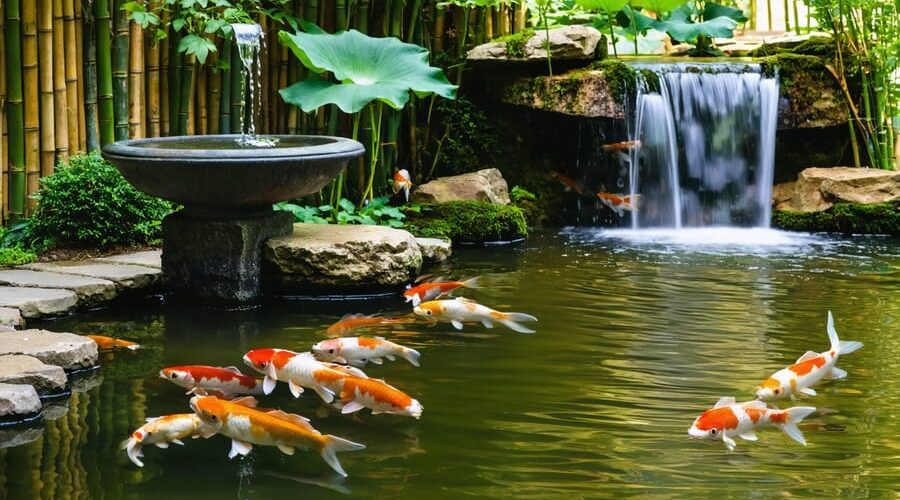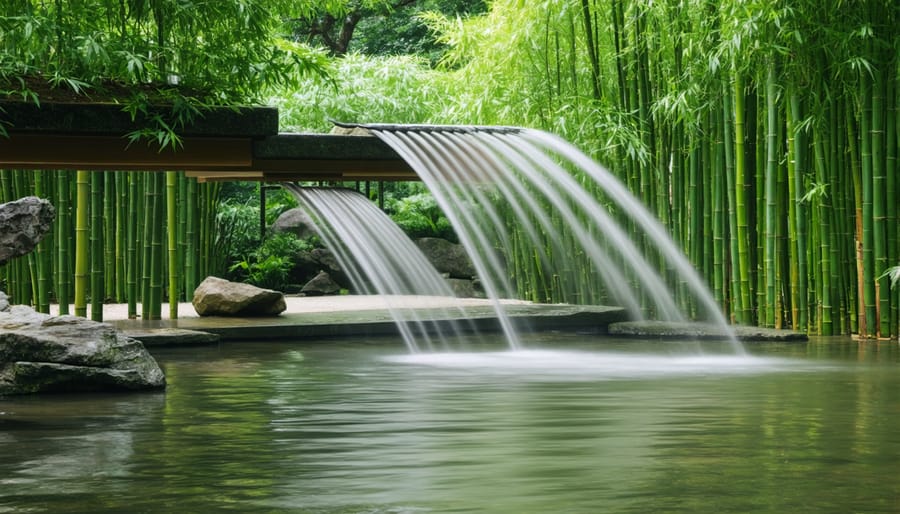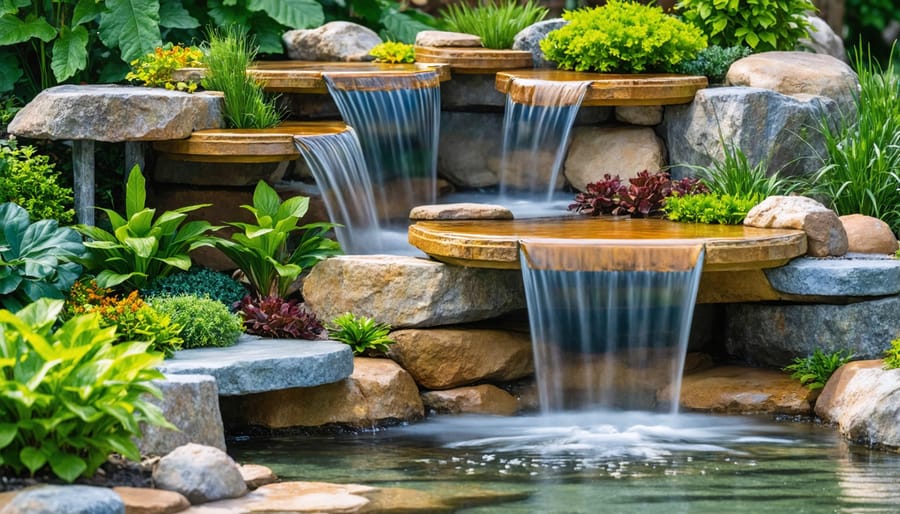
How Water Creates Music in Your Garden (Ancient Secrets Meet Modern Ponds)
Close your eyes beside your pond, and you’ll notice something’s missing. While your water garden dazzles the eyes with blooming lilies and gliding koi, it may be leaving your ears wanting more. A sound garden transforms your aquatic oasis into a multi-sensory retreat by intentionally layering water sounds, from the gentle trickle of a bamboo fountain to the rhythmic splash of a waterfall.
This isn’t a modern invention dreamed up by landscape designers. Japanese gardens have incorporated carefully orchestrated water sounds for over a thousand years, using deer scarers (shishi-odoshi) and stone basins to create moments of auditory punctuation in meditation spaces. The practice recognizes what science now confirms: specific water sounds lower cortisol levels, reduce blood pressure, and trigger the same relaxation response as meditation.
Creating your own sound garden doesn’t require exotic equipment or a massive budget. You’re simply being intentional about the acoustic dimension already present in your water feature. A standard pump and some creative positioning of rocks can generate everything from white noise that masks neighborhood sounds to musical drips that mark the passing hours.
The beauty of a sound garden lies in its customization. Whether you crave the thunderous drama of cascading water or prefer the whisper-quiet burble of a seep, you control the volume and character of your backyard soundscape. Your pond can finally engage all your senses, not just your sight.
What Is a Sound Garden?
A sound garden is much more than just a water feature that happens to make noise—it’s a deliberately designed outdoor space where water creates intentional musical and therapeutic sounds. Think of it as composing a symphony with water rather than instruments. When you walk through a sound garden, every trickle, splash, and cascade is there by design, working together to create a peaceful auditory experience that calms your mind and connects you with nature.
What separates a sound garden from a regular pond or fountain is that intentional element. We’ve all heard a dripping tap or gurgling drain pipe—those are accidental sounds that often annoy us. But a sound garden harnesses water’s natural voice through careful planning of flow rates, drop heights, surface materials, and container shapes. The result transforms random noise into purposeful soundscapes that can energize, relax, or inspire you depending on how you design them.
This isn’t a new concept we’ve just invented. Sound gardens have deep roots in ancient water garden design traditions from around the world. Japanese gardens have used shishi-odoshi bamboo fountains and carefully placed streams for centuries to create meditative sounds. Persian paradise gardens featured intricate channel systems where water sang as it flowed. Moorish gardens in Spain showcased elaborate fountain designs that turned patios into concert halls of water music.
The beauty of creating your own sound garden is that you don’t need to be an expert in hydrology or ancient architecture. With some basic understanding of how water behaves and a willingness to experiment, you can craft your own water music right in your backyard.
The Ancient Art of Water Music
Japanese Shishi-Odoshi and Bamboo Water Features
If you’ve ever visited a Japanese garden and heard that distinctive “clonk” sound, you’ve experienced a shishi-odoshi in action! This clever bamboo fountain, whose name literally means “deer scarer,” originally served a practical purpose in protecting crops and gardens from hungry wildlife. Here’s how it works: water flows into a hollow bamboo tube that pivots on a central point. As the tube fills, it becomes heavy and tips forward, emptying the water. When empty, it snaps back to its original position, striking a rock below with that satisfying clacking sound.
What started as a functional farming tool evolved into a beloved element of Japanese water garden traditions, valued for its meditative rhythm and natural aesthetic. The repetitive sound creates a peaceful atmosphere, marking time without the harshness of mechanical noise. Modern water gardeners adore these features because they’re surprisingly simple to install and maintain. You’ll need a water source, bamboo poles, and basic tools to create your own. The beauty lies in the unpredictability—the timing between clonks varies slightly based on water flow, creating an organic, living soundscape that never feels monotonous or artificial.

Persian Paradise Gardens and Flowing Water
Imagine stepping from scorching desert heat into a garden where flowing water whispers through stone channels, creating an instant sanctuary for your senses. That’s exactly what Persian garden designers mastered over 2,000 years ago, and their genius is surprisingly easy to recreate in your own backyard.
Persian paradise gardens, called “chahar bagh,” featured geometric water channels that divided the space into quarters, with fountains at intersection points. The flowing water served a brilliant dual purpose: cooling the air through evaporation while producing soothing sounds that masked the harsh desert winds. Cascading water stepped down multiple levels, creating layered acoustics that ranged from gentle trickles to more pronounced splashes.
What I love about this approach is how practical it is for today’s water gardeners. You don’t need elaborate stonework to capture that cooling sound effect. A simple raised basin feeding into lower pools creates similar cascading sounds, while a straight channel lined with smooth pebbles produces those peaceful gurgling tones. The key is creating multiple sound sources at different volumes, which adds richness to your garden’s audio landscape and transforms any space into your personal oasis.
Moorish Water Courts and Echo Chambers
The architects of medieval Spain’s Alhambra were absolute masters at turning water into music. Walking through those ancient courtyards today, you’ll notice something magical happening with the fountains and pools. The Moors didn’t just plop water features anywhere. They designed entire spaces to work like natural amplifiers.
Here’s what made their approach brilliant: they positioned fountains beneath arched alcoves that acted like echo chambers, bouncing water sounds back and forth. The trickling became a gentle roar. They also carved specific patterns into fountain bowls that changed how water splashed, creating different pitches and rhythms. Some pools were built at exact depths to produce resonant hums.
You can borrow these ideas for your own backyard. Try placing a small fountain near a corner where two walls meet, or position it under an arbor. The surrounding surfaces will naturally amplify the sound. Experiment with different fountain head patterns to find the splash sound you love. Even adding a few flat stones at angles in your water basin can create interesting acoustic effects as water hits them.
How Water Makes Different Sounds (And Why It Matters)
The Height and Distance Factor
Here’s the thing about water and sound—it’s all about gravity! When you’re designing your sound garden, think of height and distance as your volume and tone controls. I learned this firsthand when I adjusted my waterfall from a gentle 6-inch drop to a dramatic 18-inch cascade. The difference was incredible!
Higher drops create louder, more dramatic splashes. Picture water freefalling two feet into a pond—that’s your bold, attention-grabbing statement piece. It produces energetic splashing sounds that carry across your yard, perfect for masking street noise or creating a lively focal point.
On the flip side, gentle flows over shallow streams or gradual slopes create soft, soothing murmurs. Water trickling down a series of small rocks just inches apart produces those peaceful babbling sounds that invite meditation and quiet contemplation.
The distance water travels also matters. Longer horizontal flows let you layer multiple sound zones—perhaps starting with a gentle trickle that builds to a satisfying splash at the end. Experiment with different heights and distances to discover your perfect sonic signature!
Surface Impact and Material Choices
Here’s what I’ve discovered through my own water garden experiments: different materials create wonderfully distinct sounds that can completely transform your space. When water strikes natural stone or river rocks, you’ll hear a soft, earthy patter that feels grounding and natural. It’s my personal favorite for creating a calm, meditative atmosphere.
Metal surfaces like copper bowls or brass chimes produce clear, resonant tones that ring out beautifully. The sound carries further and has that crisp quality that adds energy to your garden. I placed a shallow copper dish under one of my bamboo spouts, and visitors always comment on its bell-like quality.
When water falls into existing water, you get that classic trickling sound we all love. The depth matters here: shallow pools create splashy sounds, while deeper basins produce gentle plops. Hollow objects like bamboo tubes or ceramic vessels give you percussion-like notes with surprising depth. Try a large terracotta pot on its side, and you’ll see what I mean! The fun part is mixing materials to create your own unique soundscape. Start with one or two surfaces and experiment from there.
Flow Rate and Rhythm
Think of your pump as the conductor of your water orchestra! The flow rate you choose sets the entire mood of your sound garden. A powerful pump creating high water volume produces bold, rushing sounds—perfect if you want that dramatic waterfall effect. I remember installing my first pump and being surprised at how much personality different settings could create.
For gentler, meditative sounds, dial down the flow rate. Lower volumes create soft trickles and delicate splashes that invite quiet contemplation. Most adjustable pumps let you experiment with speeds, and I encourage you to play around! Try running your pump at different settings throughout the day. You might discover that a vigorous morning flow energizes your garden routine, while a slower evening tempo helps you unwind.
The beauty is that you’re not locked into one rhythm. Seasonal adjustments work wonderfully too—perhaps a livelier tempo during summer gatherings and a peaceful pace for autumn reflection.

Creating Your Own Sound Garden: Practical Design Elements
Waterfalls and Cascades for Natural Music
Creating a waterfall that sounds as beautiful as it looks takes some thoughtful planning, but I promise it’s worth the effort! The secret lies in how water hits different surfaces and falls through space.
Start by selecting your rocks carefully. Flat, smooth stones create soft splashing sounds, while rough, textured rocks produce more energetic, bubbling notes. I like to collect a variety of sizes—some large anchor rocks and several smaller pieces for fine-tuning the sound later.
Next, build your waterfall structure with sound ledges in mind. Create shallow platforms or lips where water can pause briefly before cascading down. Each ledge adds another layer to your water symphony. Think of it like musical notes—the more ledges, the richer the composition.
The angle matters tremendously. A steep drop creates a powerful rush, while a gradual slope produces gentler trickling sounds. Experiment with angles between 30 and 60 degrees to find your preferred tone.
Here’s my favorite tip: test everything before cementing your design. Run water through your structure and listen carefully. Move rocks around, adjust heights, and redirect water flow until you discover that perfect sound that makes you smile.
Don’t rush this process. I’ve spent entire afternoons playing with rock placement, and those hours of tinkering always result in waterfalls that become the acoustic centerpiece of the garden.

Fountains That Sing
There’s something magical about a fountain that does double duty—creating visual interest while adding musical notes to your garden. I’ve spent countless hours experimenting with different fountain styles, and I can tell you each one has its own voice.
Bubbling fountains produce gentle, meditative sounds perfect for quiet contemplation spaces. These work wonderfully near seating areas where you want soothing background noise without overwhelming conversation. Tiered fountains create a cascading symphony as water travels from level to level—think of them as the string section of your water orchestra. The wider the tiers, the softer the sound. Spray fountains add drama with splashing, tinkling notes that energize a space.
Placement makes all the difference in your fountain’s acoustic performance. Position fountains near walls or dense plantings to amplify their sound naturally through reflection. For softer effects, surround them with absorbing materials like mulch or ground covers.
Here’s my hard-learned lesson: bigger isn’t always better. An overpowering fountain can become annoying quickly, especially near windows or patios. Start with adjustable pump settings so you can fine-tune the volume. Consider your neighbors too—what sounds peaceful to you at noon might disturb them at dawn. Test your fountain at different times before committing to a permanent installation spot.
DIY Bamboo Water Spouts
Creating your own bamboo water spout is easier than you might think, and the results are absolutely magical! I still remember the first time I heard mine start clacking in my backyard – it felt like I’d brought a piece of a Japanese temple garden home.
Start by gathering hollow bamboo poles in varying diameters. You’ll need at least one thick piece (3-4 inches wide) for the main spout and smaller sections if you want that classic shishi-odoshi clacking effect. Hardware stores often carry bamboo, or check online specialty suppliers. You’ll also need a small submersible pump, flexible tubing, waterproof sealant, and mounting brackets.
For a simple pouring spout, cut your bamboo at an angle to create a lip, then seal one end completely. Drill a hole near the sealed end for your tubing, which connects to your pump submerged in a basin or pond. Secure the bamboo at a slight downward angle using brackets attached to stakes or rocks.
Want that satisfying clacking sound? Create a pivoting spout that fills with water, tips to empty, then bounces back against a striker stone. This requires cutting the bamboo with one end open, mounting it on a pivot point, and positioning it to strike a rock as it resets. The rhythm becomes incredibly soothing once you’ve adjusted the water flow just right!
Underwater Sound Elements
Here’s where things get really creative! One of my favorite discoveries was learning about submerged bells in traditional Japanese water gardens. These bells hang just beneath the water surface, creating ethereal, dampened tones when gently struck by flowing water or moving fish. You can recreate this effect using brass or ceramic bells suspended from a decorative stand positioned in shallow areas of your pond.
Resonating chambers offer another fascinating option. These are hollow vessels, like large clay pots or bamboo tubes, positioned partially underwater with openings facing the water flow. As water moves past these openings, it creates haunting, flute-like tones that change with water pressure and flow speed. I’ve experimented with different sized containers to find which produces the most pleasing sound for my space.
For a simpler approach, try strategically placing river stones or lava rocks where water flows over them. The key is creating pockets and channels that trap air bubbles, producing gentle gurgling and bubbling sounds. Stack them at varying heights to create a natural cascade effect that maximizes these delightful acoustic textures.
Plant Companions for Enhanced Acoustics
The plants you choose around your water features can truly amplify your sound garden experience! I’ve discovered that grasses like bamboo and ornamental varieties create the most delightful rustling melodies when breezes pass through. Their hollow stems and slender leaves act like natural wind chimes, adding layers of gentle whispers to your water sounds.
Dense plantings work wonderfully as sound directors too. Position taller shrubs and hedges strategically to guide sounds toward seating areas or deflect noise from neighboring properties. Think of them as acoustic walls that soften harsh echoes while preserving the soothing tones you want to hear.
For a fuller sensory experience inspired by traditional water gardens, try combining different textures. Pair broad-leafed hostas with feathery ferns near your fountain—the contrast creates varied sound patterns as water droplets strike different surfaces. Reed-like plants around pond edges add that satisfying rustle that complements flowing water perfectly.
Balancing Sound: Too Much vs. Just Right
I learned this lesson the hard way when my enthusiastic first waterfall project had my neighbor knocking on my door within a week. I’d positioned a powerful pump too close to our shared fence, creating what she diplomatically called “a constant roar.” Oops! Finding the sweet spot between soothing ambiance and neighborhood nuisance is crucial for sound garden success.
The most common mistake is simply going too big with your pump. More gallons per hour doesn’t equal better sound—it often equals annoying sound. Start conservatively. You can always increase flow later, but toning down an overpowering feature requires expensive adjustments or complete redesigns. A gentle trickle at 200-400 gallons per hour often creates more pleasant sounds than a rushing 1000 GPH torrent.
Location matters enormously. Position your loudest features away from property lines and bedroom windows—both yours and your neighbors’. Consider where people gather in your yard. A fountain that’s pleasant from your patio might be overwhelming right next to a quiet reading nook. Walk around your entire property while the water runs, listening from different distances and angles.
Seasonal adjustments keep things harmonious year-round. That bubbling brook that’s perfect in summer might sound surprisingly loud on quiet winter evenings when leaves aren’t rustling and windows stay closed. I keep my pump on a variable speed controller, dialing it down about 30 percent in fall and winter. This simple tweak prevents complaints and actually extends pump life.
Remember, your sound garden should invite relaxation, not provoke tension. When neighbors compliment your peaceful oasis instead of complaining about noise, you’ve achieved the perfect balance. Trust your ears, stay flexible, and don’t be afraid to make adjustments until everything sounds just right.
Maintenance Tips for Long-Lasting Water Music
Keeping your water features singing beautifully requires just a bit of regular attention—nothing complicated, I promise! Think of it like tuning a musical instrument; a little maintenance goes a long way.
Start by checking your pump intakes weekly during active months. Debris, algae, and leaves love to clog these openings, which reduces water flow and silences your musical rocks. Simply remove the pump housing and rinse the intake screen under running water. I learned this the hard way when my favorite trickling sound faded to silence one summer!
Mineral buildup is another challenge, especially if you have hard water. Those white crusty deposits on your rocks don’t just look unsightly—they actually change the sound by altering water flow patterns. Every month or so, gently scrub your rocks with a soft brush and a 50/50 vinegar-water solution. Rinse thoroughly afterward to protect your fish and plants.
Seasonal adjustments keep things harmonious year-round. As water levels drop in summer heat, repositioning rocks slightly maintains your desired sound. In autumn, increase cleaning frequency as falling leaves create extra work for your pump.
Winterization is crucial in cold climates. Before the first hard freeze, remove pumps and store them in a bucket of water in your basement to prevent seals from drying out. Drain water from elevated features to prevent freeze damage. Come spring, you’ll be ready to restore your garden symphony with minimal effort!
Creating your own sound garden doesn’t require expensive equipment or expert knowledge—just a willingness to listen and experiment. Whether you’ve added a simple bamboo fountain, positioned smooth river stones beneath a waterfall, or created an elaborate spiritual water garden oasis with multiple sound elements, you’ve taken the first step toward transforming your outdoor space into something truly special.
Remember, there’s no single right way to design your sound garden. Your preferences matter most. Start with one element that speaks to you—perhaps a dripping feature for gentle meditation or cascading water for energizing mornings. Listen closely over several days, adjust the flow rate, reposition stones, and notice how different sounds make you feel.
The beauty of water gardening lies in its evolving nature. Your sound garden will change with the seasons, with plant growth, and with your growing confidence to try new elements. Don’t be afraid to experiment, make mistakes, and discover what brings you joy. Start small this weekend, and before you know it, you’ll have created your own peaceful tradition—one beautiful sound at a time.
